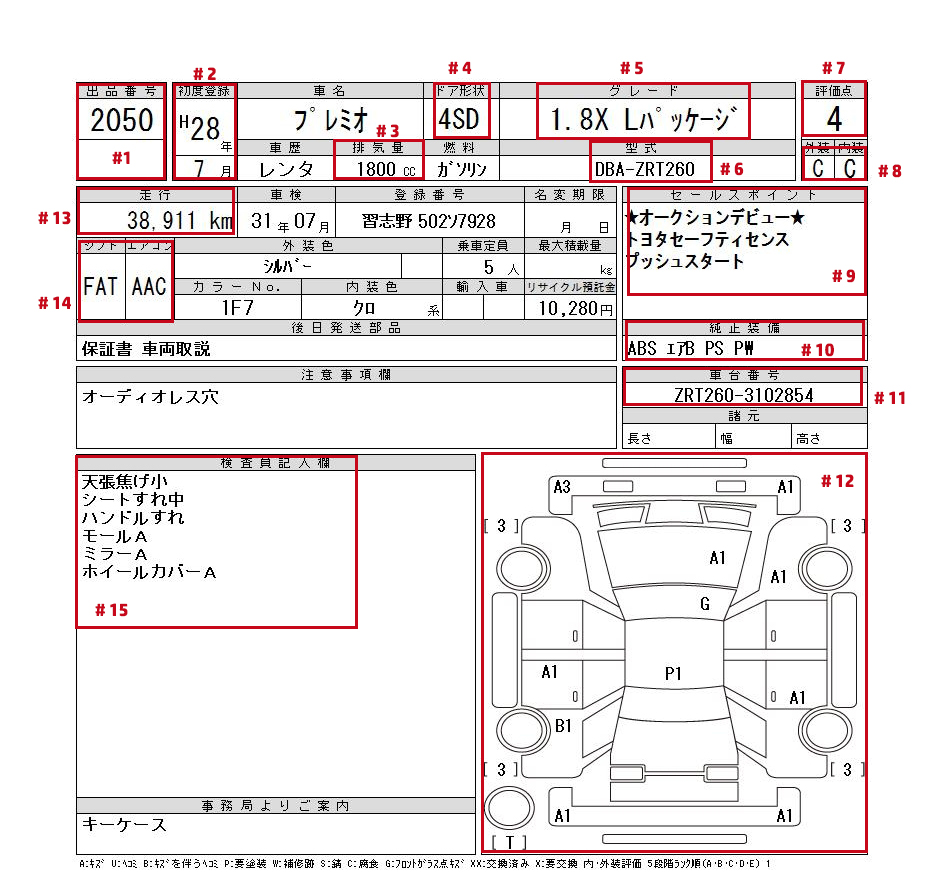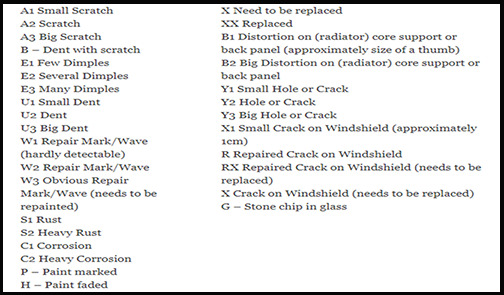
There are thousands of cars available on auction on daily basis and they are divided into different lots. A lot number is given to a set of different cars to help identify and locate a car, lot number is also used to validate an auction report once a person purchases a certain car. Normally cars data can be verified upto 90 days after the auction.
Production year and month of each car is written in auction report to give the exact age of the car to the potential buyer; in Japan their years start from 1988 (when they kingship was changed) so in the example above this car has 17 as year which mean 17 years from 1988 which makes it 2005 and 6 is the month which makes the car a production of June 2005.
This part is the engine displacement part where the engine size of a vehicle is written, in our example sheet that is 2000cc
The part where it says 4D it simply stands for 4 Doors.
This is where the car type is written; the specimen auction sheet if of Toyota Premio 1.8 X L where X L is the variant and 1.8 is the code given by engine size, for eg if it were XL 2.4 then the car would’ve been 2400cc Premio
Every Car in Japan is known by its chassis code more than anything else; the famous CL-7 & CL-9 are chassis codes of accord CL series while 7 and 9 identify different displacements within the same body code. This part is where the chassis code is written which is GXE10 for Altezza 2000cc and TA is given for Toyota.
Overall condition of car is given a grading which starts from S (Brand new) and then 6, 5, 4, and so on in descending order coming down as the quality of car decreases. if there’s a car with auction grade R then its repaired and XX is for damaged car.
This is the the part where quality of exterior is written on the left and interior on right, for eg. C is quality of exterior (A being highest) and B is quality of interior (A being highest)
This is the part where seller gives his comments about the car which unfortunate for us is written in Japanese instead of English.
This is the part where accessories / features are mentioned that said car has. ABS is for ABS brakes, PS for Power Steering and PW for power windows, if the car had navigation then it would’ve been displayed here too.
This is where a car’s chassis number is mentioned which is required to authenticate a purchase.
TThis diagram gives exact idea of a car’s condition as what has happened to the body and if there are any faults / flaws. Each alphabet is given for a specific reason and the meaning of all is universal across all over Japan, this is how you read these.

This is the part where a car’s mileage is mentioned.
Now here the transmission type and air conditioner type is mention which FAT means Floor-Shift Automatic Transmission and AAC is for Automatic Air Condition (Climate Control).
When the auction house surveys a car he writes his comments about the condition of a car which are mentioned in this part.
A few more things which are not mentioned in this auction report but a few auction houses mention is weather car is front wheel, rear wheel or all wheel drive which are mentioned 2FWD, 2RWD and 4WD respectively. Also some auction houses mention the weight of car which is written in kg. Different auction houses have different designs of auction sheets so the places may differ where certain thing is mentioned however all the auction reports carry the same information as in the one given above.
